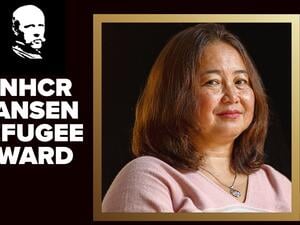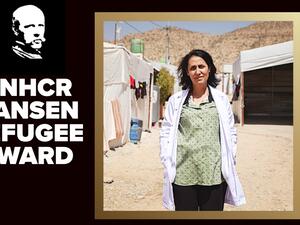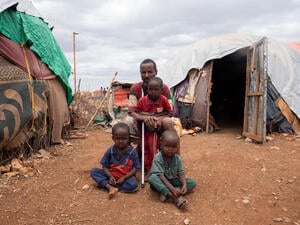Head of UNHCR operations division shocked by condition of Somali displaced
Head of UNHCR operations division shocked by condition of Somali displaced

Family members care for paralyzed nine-year-old Ahmed at Galkayo, where conditions are tough. Assistant High Commissioner for Refugees Judy Cheng-Hopkins visited the area this week and was shocked by conditions.
GALKAYO, Somalia, May 4 (UNHCR) - Top UNHCR official Judy Cheng-Hopkins has said at the end of a four-day trip to south-central Somalia that she was shocked by the living conditions of people who have been displaced after fleeing recent heavy fighting in Mogadishu, the Somali capital.
The Assistant High Commissioner for Operations, who flew into Somalia on Monday and visited internally displaced persons (IDPs) in Baidoa and Galkayo, made the observation before leaving for Nairobi on Thursday morning.
In Baidoa, some 230 kilometres north-west of Mogadishu, where nearly 19,000 newly displaced people have arrived, Cheng-Hopkins visited several IDP settlements which have swollen with the new influx of arrivals. The new arrivals live in flimsy shelters made of fabric wrapped around sticks. Some families have not been able to find enough material to cover the entire shelter, and the lack of plastic sheeting is leaving them exposed to heavy rain at night.
Nourtou, who was looking after her three children and five orphaned nephews, told Cheng-Hopkins at her flimsy shelter in Baidoa that she had fled Mogadishu on April 15. "I cannot sleep at night. I am too afraid that my children might get soaked during the night and become sick, especially since they lack food," she said.
Like most of the recently displaced persons, Nourtou said she wanted to go back to Mogadishu, but not for the moment. "Even though the Transitional Federal Government (TFG) says the city is peaceful again and called for the displaced to return, these are only words", she said. "I still fear that fighting might resume."
Fifteen-year-old Choukri and her sisters, who fled Mogadishu a few weeks ago to live with relatives in Baidoa, also want to go back. "Mogadishu is a big city where it is more pleasant to live," she said in good English, adding that she was missing school.
An estimated 394,000 people have fled Mogadishu since the beginning of February. Although a few have returned to the city from nearby areas, most - like Nourtou and Choukri - are waiting to see how the security situation develops. Some have had their houses destroyed, others cannot afford the cost of transportation back to the capital.
People who lived in settlements inside former government buildings in Mogadishu are afraid they might not be allowed to return there by the TFG, which has declared its intention to evict them in order to make the buildings operational again. UNHCR is negotiating with the TFG to make sure these people are relocated on land within Mogadishu which is economically viable and with enough utilities and infrastructure.
After visiting Baidoa, Cheng-Hopkins visited settlements of displaced people in Galkayo, Puntland, some 700 kilometres north of Mogadishu, where more than 10,000 people are estimated to have arrived recently.
This has put further strain on a town that hosted an estimated 28,000 people displaced by earlier conflict. UNHCR has been in Galkayo since January and has distributed non-food items such as plastic sheeting and mattresses.
The Assistant High Commissioner said UNHCR's priority should be to target first those who are getting no support from relatives or clan members. She said UNHCR must focus on the internally displaced but without excluding their host communities which are equally needy. "In Somalia, so many people are poor that it is sometimes difficult to make a distinction between internally displaced people and the local poor population, as all live in slum-like conditions," she said.
Cheng-Hopkins added that the UN refugee agency intended to scale up its efforts in places like Baidoa and Galkayo. In the latter, she met one young mother who was afraid that her flimsy shelter would not keep out the rain, snakes or hyenas that roam around the settlement at night.
The UNHCR official also met with ministers of the TFG in Baidoa and visited several hospitals that are short of medical supplies. Access to people was key to the humanitarian efforts in Somalia, she said. The operating environment remains insecure and there are fears that flooding might impair access to Afgooye, a town 30 kilometres north-west of Mogadishu where more than 43,000 people have settled. UNHCR and its partners have distributed aid for some 50,000 people in Afgooye and surrounding areas.
Relief items for distribution by UNHCR have recently been flown to Somalia. The refugee agency plans an airlift of non-food aid in the coming weeks using the recently reopened K50 airport located 50 kilometres from Mogadishu.
The agency will be appealing for more funds shortly to help Somalis displaced within the country and in surrounding countries. UNHCR currently has a budget of US$5.7 million for Somalia, but that was before the mass exodus from Mogadishu.
UNHCR's estimates for the number of displaced have been compiled using data provided by a network of aid agencies. Among the almost 400,000 displaced, an estimated 152,000 people have headed to the nearby Shabelle provinces (84,000 people in Lower Shabelle and 68,000 in Middle Shabelle). Another 109,000 people have gone to Galgaduud region; 44,000 to Hirran region; 40,000 to Mudug; and 28,000 to Bay region. The numbers of IDPs leaving Mogadishu have dropped dramatically in recent days as fighting has eased.
By Catherine Weibel in Galkayo and Baidoa, Somalia









